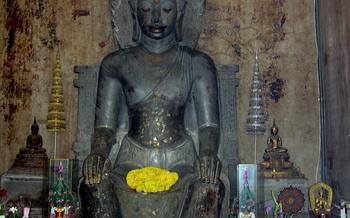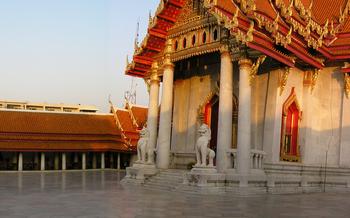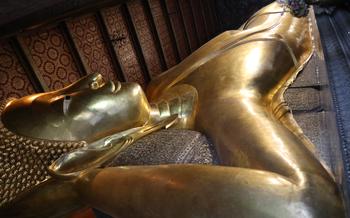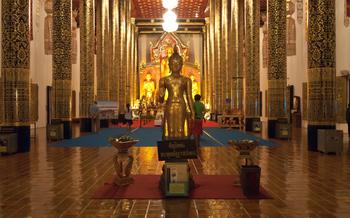
Wat Ban Na Kha Thevi
- Wat Ban Na Kha Thevi: A Journey Through History and Spirituality
- Spiritual Significance
- Religious Ceremonies and Festivals
- Symbolism and Iconography
- Main Structures
- Mural Paintings
- Buddha Images
- Ordination Hall (Ubosot)
- Monastery Grounds
- Visitor Etiquette
- Festivals and Events
- Local Crafts and Products
- Nearby Attractions
- Getting There
- Opening Hours and Admission:
- Accommodation
- Insider Tip: Unveiling the Hidden Gem
Wat Ban Na Kha Thevi: A Journey Through History and Spirituality
Wat Ban Na Kha Thevi, located in the heart of Udon Thani, Thailand, stands as a testament to the rich cultural heritage and spiritual significance that permeates the region. This ancient temple, believed to have been constructed in the 16th century, holds a profound place in the hearts of the local community and attracts visitors from around the world.
Historical Background and Cultural Significance:
Wat Ban Na Kha Thevi's history is deeply intertwined with the rise of Buddhism in Thailand. It is believed to have been founded by a group of monks who were seeking a place to establish a monastic community. Over the centuries, the temple grew in prominence and became a center for religious teachings and practices. Today, it remains an active place of worship and a source of spiritual guidance for the local community.
Architectural Styles and Unique Features:
The temple's architectural design is a blend of traditional Thai and Khmer influences, reflecting the cultural diversity of the region. Intricate carvings, elaborate murals, and colorful mosaics adorn the temple's structures, adding to its visual splendor. One of the most striking features of Wat Ban Na Kha Thevi is its towering prang, a distinctive spire that rises above the surrounding landscape, symbolizing the temple's spiritual significance and connection to the heavens.
Past Renovations and Preservation Efforts:
Over the years, Wat Ban Na Kha Thevi has undergone several renovations and restoration projects to preserve its historical integrity and architectural beauty. These efforts have been undertaken with the utmost care and attention to detail, ensuring that the temple's original features and sacredness are maintained. The temple's dedication to preserving its heritage has earned it recognition as a significant cultural and religious site in Thailand.
Spiritual Significance
Wat Ban Na Kha Thevi holds immense spiritual significance as a sacred Buddhist site. The temple serves as a place of worship, meditation, and religious ceremonies for the local community and visitors alike. Throughout the year, the temple hosts various Buddhist festivals and events, attracting devotees from near and far.
Religious Ceremonies and Festivals
One of the most important festivals celebrated at Wat Ban Na Kha Thevi is Songkran, the Thai New Year. During Songkran, the temple becomes a hub of activity, with water-splashing rituals, merit-making ceremonies, and processions of Buddha images. Other significant festivals include Visakha Bucha, which commemorates the birth, enlightenment, and passing of Buddha, and Loi Krathong, where people release floating lanterns into the sky to pay respect to the water spirits.
Symbolism and Iconography
The temple's design and decorations are rich in Buddhist symbolism and iconography. The murals and sculptures depict scenes from the life of Buddha, as well as stories from Thai mythology and folklore. These artistic representations serve as visual reminders of the teachings and values of Buddhism, inspiring contemplation and devotion among visitors.
Main Structures
Wat Ban Na Kha Thevi is composed of several significant buildings, each serving a distinct purpose. The ubosot, or ordination hall, is the most sacred structure within the temple complex. It features a striking golden roof, intricate carvings adorning its exterior walls, and a series of Buddha images positioned along the interior walls. The intricate details and craftsmanship of the ubosot reflect the temple's rich history and devotion to Buddhism.
Another notable structure is the viharn, or assembly hall, which serves as a gathering place for monks and devotees. Its spacious interior is adorned with colorful murals depicting stories from the life of Buddha and Thai folklore. The intricate paintings, executed with precision and artistry, captivate visitors with their vivid colors and detailed narratives.
The chedi, or stupa, is a tall, bell-shaped structure that symbolizes the Buddha's attainment of enlightenment. It is located at the rear of the temple complex and serves as a repository for sacred relics. The chedi's towering presence adds to the temple's grandeur and creates a sense of awe and reverence among visitors.
Mural Paintings
Wat Ban Na Kha Thevi is renowned for its exquisite mural paintings that adorn the interior walls of the temple's buildings. These murals are not mere decorations but hold deep spiritual and cultural significance, narrating tales from Buddhist mythology, Jataka stories, and the life of Buddha. The intricate artwork showcases the skill and artistry of ancient Thai craftsmen, who employed a variety of techniques to create these vibrant and enduring masterpieces.
The murals depict a vast array of subjects, including scenes from the heavens and hells, the lives of previous Buddhas, and the miraculous events surrounding Buddha's birth, enlightenment, and passing into Nirvana. These paintings serve as visual representations of Buddhist teachings, inviting visitors to contemplate the principles of karma, rebirth, and the path to enlightenment.
One of the most striking murals depicts the story of Prince Siddhartha's encounter with the four sights that led him to renounce his royal life and seek spiritual awakening. Another notable mural portrays the story of Phra Malai, a legendary monk who traveled to various realms of existence, encountering both heavenly and hellish beings. These murals not only captivate visitors with their artistic beauty but also offer profound insights into Buddhist cosmology and philosophy.
The murals at Wat Ban Na Kha Thevi have stood the test of time, despite the challenges of humidity, heat, and natural wear and tear. Conservation efforts have been undertaken to preserve these precious artworks, ensuring that future generations can continue to appreciate their beauty and significance.
Buddha Images
Wat Ban Na Kha Thevi is home to a diverse collection of Buddha images, each imbued with unique symbolism and significance. These revered representations of the Buddha are enshrined within the temple's sacred spaces, evoking a sense of awe and reverence among visitors.
The most prominent Buddha image is the Phra Ubosot, a colossal bronze statue seated in the temple's main ordination hall. Towering over the hall, the Phra Ubosot exudes an aura of majesty and commands attention with its intricate details and serene expression. Depicted in the classic "Calling the Earth to Witness" posture, the Buddha's right hand touches the ground, symbolizing his triumph over the forces of evil.
Another notable Buddha image is the Phra Buddha Saiyas, a reclining Buddha statue located in a dedicated pavilion within the temple complex. This colossal figure stretches over 15 meters in length, inviting visitors to contemplate the Buddha's teachings on impermanence and the cycle of rebirth. The serene countenance of the Phra Buddha Saiyas radiates compassion and tranquility, inspiring a sense of inner peace.
Throughout the temple grounds, visitors will encounter numerous smaller Buddha images, each with its own story to tell. These images vary in size, style, and posture, reflecting the diverse artistic traditions that have influenced the temple's development. Some Buddha images are depicted with their hands in the "Dharmachakra Mudra," symbolizing the teaching of the Buddha's doctrine, while others display the "Abhaya Mudra," representing protection and reassurance.
The Buddha images at Wat Ban Na Kha Thevi are not mere objects of art; they are living embodiments of the Buddha's teachings and a source of inspiration for devotees. Visitors are encouraged to take a moment to pause and contemplate the significance of these sacred images, allowing their presence to evoke a sense of peace, mindfulness, and spiritual awakening.
Ordination Hall (Ubosot)
The ubosot, also known as the ordination hall, holds a central and sacred position within the temple complex of Wat Ban Na Kha Thevi. As the primary ceremonial hall, it serves as a venue for significant rituals and events, including ordinations, the formal process by which individuals become Buddhist monks. The ubosot's architectural features and symbolism reflect its importance.
The ubosot's design adheres to traditional Thai temple architecture, characterized by a rectangular shape with a multi-tiered roof. The roof's intricate decorations, often adorned with colorful tiles and elaborate carvings, represent the celestial realm and the journey towards enlightenment. The entrance to the ubosot is typically marked by a grand doorway, flanked by guardian deities or mythical creatures symbolizing protection and reverence.
Inside the ubosot, the main feature is the elevated platform, where the ordination ceremonies take place. The platform is adorned with intricate carvings, sculptures, and murals depicting scenes from Buddhist mythology and the life of the Buddha. The walls of the ubosot are often adorned with vibrant murals and paintings, narrating significant Buddhist tales and teachings, serving as a visual guide for spiritual contemplation.
The ubosot is not only a physical space for rituals but also a symbolic representation of the Buddhist path. The ordination platform symbolizes the threshold between the secular world and the sacred realm of monastic life. The murals and decorations within the ubosot serve as reminders of the principles, virtues, and teachings that guide Buddhist practitioners on their spiritual journey.
Monastery Grounds
The monastery grounds of Wat Ban Na Kha Thevi provide a serene and contemplative environment for the monks who reside there. The living quarters for the monks are simple and modest, reflecting their commitment to a life of detachment and simplicity. Daily life for the monks revolves around meditation, study, and the performance of religious ceremonies. They rise early in the morning for prayers and meditation, and spend much of their day studying Buddhist scriptures and practicing mindfulness. In the evenings, they often gather for communal chanting and meditation sessions.
The monks at Wat Ban Na Kha Thevi are highly respected members of the local community. They are often sought out for advice and guidance on religious and spiritual matters, and they play an important role in preserving and transmitting Thai Buddhist traditions. Visitors to the temple can interact with the monks and learn more about their way of life. Many monks are fluent in English and other foreign languages, and they are happy to answer questions and share their insights on Buddhism and Thai culture.
Visitor Etiquette
When visiting Wat Ban Na Kha Thevi, it's essential to observe proper etiquette to show respect for the temple's sacredness and its community. Here are some guidelines to keep in mind:
Dress Code: Dress modestly and appropriately. Avoid wearing shorts, revealing clothing, or anything that might be deemed disrespectful. Opt for lightweight, loose-fitting clothing that covers your shoulders and knees.
Footwear: Remove your shoes before entering the temple's main buildings, including the ubosot and viharn. Place your shoes neatly on the designated shoe racks provided.
Behavior: Be mindful of your behavior and maintain a respectful demeanor throughout your visit. Avoid loud talking, laughing, or engaging in any activities that might disrupt the temple's serene atmosphere.
Photography: Photography is generally permitted within the temple complex, but it's essential to be respectful and avoid taking photos that might be intrusive or disrespectful to the monks or other visitors.
Interactions: If you wish to interact with the monks, do so politely and respectfully. Avoid asking personal questions or engaging in conversations that might disrupt their meditation or daily activities.
Donations: Donations are welcome and appreciated at Wat Ban Na Kha Thevi. There are designated donation boxes located throughout the temple complex where you can make offerings.
Festivals and Events
Wat Ban Na Kha Thevi comes alive during various festivals and events throughout the year. These celebrations offer a vibrant glimpse into Thai culture and traditions, attracting both locals and visitors alike. One of the most significant festivals is Songkran, the Thai New Year, which takes place in April. During Songkran, the temple grounds are adorned with colorful decorations, and locals engage in water-splashing activities to symbolize cleansing and renewal.
Another important event is Loi Krathong, the Festival of Lights, which occurs in November. During Loi Krathong, visitors can witness the release of beautifully decorated krathongs (floating baskets) into the nearby river, accompanied by prayers and wishes for good luck and prosperity. Other festivals celebrated at the temple include Makha Bucha, Visakha Bucha, and Kathina, each with its own unique rituals and ceremonies. Participating in these festivals is an excellent way to immerse oneself in the spiritual and cultural traditions of Thailand.
Local Crafts and Products
Wat Ban Na Kha Thevi is not only a sacred temple but also a hub for traditional Thai craftsmanship. The local community is home to skilled artisans and craftsmen who create exquisite handicrafts using techniques passed down through generations. Visitors to the temple can purchase unique souvenirs and items that showcase the region's rich cultural heritage.
One of the most popular items is the amulet, a small pendant often worn for protection or good luck. Amulets at Wat Ban Na Kha Thevi are carefully crafted by local artisans using sacred materials and traditional methods. They are believed to possess special powers and are often inscribed with auspicious symbols or mantras.
Ceramics are another popular craft in the area. Visitors can find a variety of ceramic items, from intricate sculptures to delicate pottery. These ceramics are made using local clay and are often hand-painted with beautiful designs.
Textiles are also a specialty of the local artisans. Visitors can find a variety of woven fabrics, including silk, cotton, and linen. These fabrics are often used to make traditional Thai clothing, such as sarongs and scarves.
By purchasing local crafts and products, visitors can not only take home a unique souvenir but also support the local community and help preserve Thailand's rich cultural heritage.
Nearby Attractions
Wat Ban Na Kha Thevi is nestled in a region rich in cultural and historical significance. Embrace the opportunity to delve deeper into the region's heritage by exploring nearby attractions. For those seeking spiritual enlightenment, the sacred temples of Wat Pa Phu Kon and Wat Pa Phu Kong await your visit. Immerse yourself in the tranquility of these serene sanctuaries, each offering unique architectural wonders and a glimpse into the region's religious traditions.
History buffs will delight in exploring the ancient ruins of Ban Chiang, a UNESCO World Heritage Site. Unearth the secrets of this prehistoric settlement, where excavations have revealed Bronze Age artifacts and provided valuable insights into Thailand's earliest civilizations.
Nature lovers can find solace in the picturesque Phu Phan Mountains, a national park renowned for its breathtaking landscapes. Embark on a rejuvenating hike through lush forests, marvel at cascading waterfalls, and capture the mesmerizing views from scenic viewpoints.
Enrich your journey by visiting local markets and interacting with the friendly community members. Discover hidden gems, savor authentic Thai cuisine, and support local artisans by purchasing unique handmade crafts. Embrace the vibrant culture and warm hospitality that define this region.
Whether you seek spiritual fulfillment, historical exploration, or natural wonders, the vicinity of Wat Ban Na Kha Thevi offers an array of experiences that will leave you captivated. Tailor your itinerary to match your interests and create lasting memories in this enchanting corner of Thailand.
Getting There
Reaching Wat Ban Na Kha Thevi is a breeze, with several transportation options available. From major cities like Bangkok, hop on a direct bus or train that will take you straight to Udon Thani, the province where the temple resides. Once in Udon Thani, local buses and songthaews (shared taxis) can whisk you to the temple's doorstep. If you prefer a more scenic journey, rent a car or motorbike and embark on a leisurely road trip, enjoying the tranquil landscapes along the way.
For those who prefer a guided experience, joining a tour group is a great option. These tours typically include round-trip transportation from your hotel and provide insightful commentary on the temple's history and significance. Whether you choose to navigate independently or with a group, make sure to have a map or GPS device handy to ensure a smooth journey.
Opening Hours and Admission:
Wat Ban Na Kha Thevi is open to visitors daily from 8:00 AM to 5:00 PM. Admission to the temple is free of charge, as it is customary in Buddhist temples in Thailand. However, donations are welcome and greatly appreciated to support the temple's upkeep and maintenance.
To ensure a peaceful and serene experience, it is advisable to visit the temple early in the morning or late in the afternoon, when there are fewer crowds. This will allow you to take your time exploring the temple grounds and admiring the intricate details of the murals and Buddha images without distractions.
It is important to be respectful of the temple's sacred nature and adhere to the local customs and protocols. Visitors are expected to dress modestly, covering their shoulders and knees, and to remove their shoes before entering the temple buildings. It is also customary to bow or wai in front of Buddha images as a sign of reverence.
By following these guidelines, you can ensure a meaningful and enriching visit to Wat Ban Na Kha Thevi, experiencing the cultural and spiritual significance of this ancient temple while respecting the local traditions and customs.
Accommodation
When planning your visit to Wat Ban Na Kha Thevi, a range of accommodation options are available to suit different preferences and budgets. Whether you seek a luxurious hotel experience, a cozy guesthouse, or a homestay that offers a glimpse into local life, you'll find suitable options nearby.
For those seeking convenience and proximity to the temple, several hotels are located within walking distance. These hotels offer modern amenities, comfortable rooms, and easy access to other attractions in the area.
Guesthouses provide a more budget-friendly alternative, often offering basic but clean and comfortable rooms. Many guesthouses are run by friendly locals who can provide valuable insights into the community and surrounding area.
For a truly immersive experience, consider staying at a homestay. Homestays allow you to live with a local family, sharing meals, participating in daily activities, and gaining a deeper understanding of Thai culture.
When choosing accommodation, consider factors such as proximity to the temple, amenities, and your budget. It's advisable to book your accommodation in advance, especially during peak tourist seasons or major festivals.
Insider Tip:
For a unique and memorable experience, consider staying at a homestay in the village near Wat Ban Na Kha Thevi. This will give you a chance to immerse yourself in local life, learn about Thai culture, and make lasting connections with the community.
Insider Tip: Unveiling the Hidden Gem
As you wander through the temple complex, keep an eye out for a secluded corner behind the main ubosot. Here, amidst lush greenery and cascading flowers, lies a hidden gem that few visitors know about. It's a small, serene pond adorned with vibrant lotus blossoms, creating a picturesque scene that invites contemplation and tranquility.
Take a moment to pause by the pond's edge, letting the gentle breeze carry the sweet fragrance of the lotus flowers. Observe the vibrant colors of the blossoms, each petal a testament to the beauty and resilience of nature. As you soak in the serene atmosphere, allow your mind to find stillness and appreciate the simple joys of the present moment.
This hidden gem is a reminder that sometimes the most rewarding experiences are found off the beaten path. Embrace the opportunity to discover this tranquil oasis, where you can connect with the natural world and find a moment of peace amidst the bustling temple grounds.





